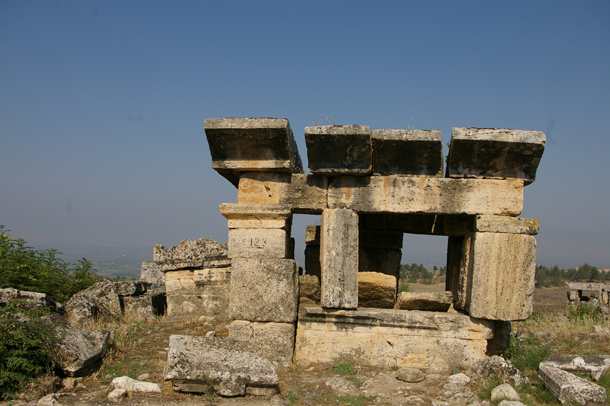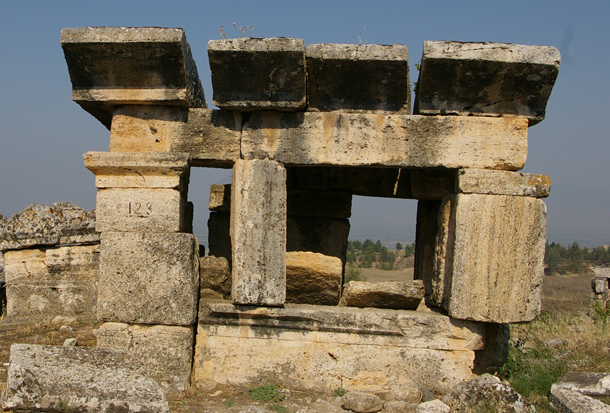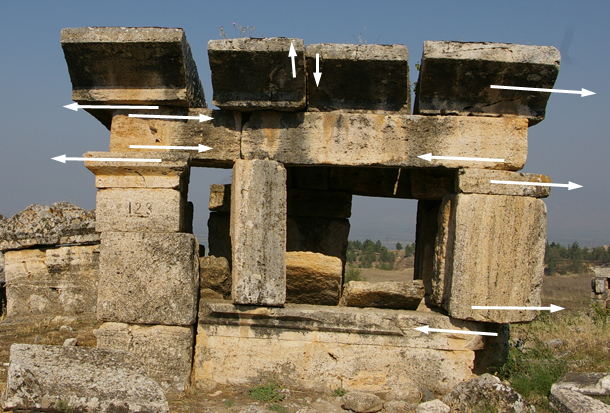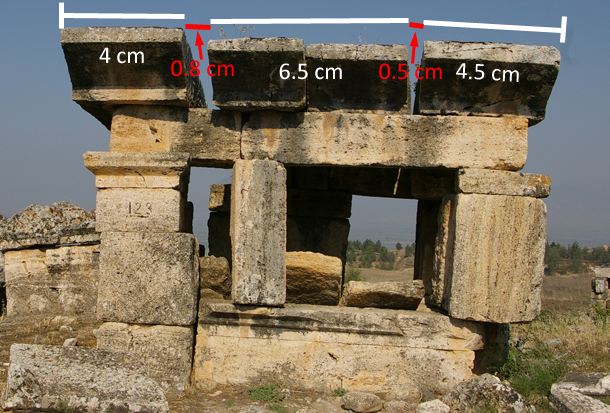This summer, strolling atop the massive travertine terraces of Pamukkale, Turkey, I checked out the necropolis (graveyard) of Hierapolis, an ancient city founded around 200 BCE and abandoned after an earthquake in 1534. One thing that caught my eye there was this tomb, built of travertine blocks:

A closer look is below, so we can check out its extended and dismembered nature:

Many offsets can be observed between the different blocks:

These appear to dominantly show stretching of the tomb in a downhill (towards the right) direction, though some blocks show an uphill displacement (like the leftmost two). So gravity may be a primary driver of this tomb deformation, but perhaps it is helped by occasional seismic shaking. Who knows? Perhaps even tomb raiders play a role in disturbing these ancient sites.
Putting a ruler up to the computer screen (and assuming a minimal amount of distortion by the lens and perspective), I measured coherent segments of the roof, and also the gaps in between them:

This data allows us to play some strain games…
4 + 6.5 + 4.5 cm = original length (at photo scale) = lo = 15 cm
0.8 + 0.5 cm = net amount of total additional length imparted due to deformation (at photo scale) = 1.3 cm
final length (from one end of the white bar to the other) = lf = 15+ 1.3 = 16.3 cm
Stretch (S) = (lf-lo)/lo = 1.3/15 = 0.087
elongation (e) = lf/lo = 16.3/15 = 1.087
(No units on S and e, as the cm’s cancel out in the division)
Note that: S+1 = e
At least as far as the “roof” blocks are concerned, this tomb has been stretched by 8.7% of its original length, resulting in a present-day length that is 108.7% of its original length.

Cute post! I like looking at the cracks in the walls of my house (we’re on shrink/swell clay) and trying to determine if I have normal, reverse or strike-slip faulting 🙂
Nice post!
This is what Klaus Hinzen talked about recently (http://www.emsc-csem.org/News/esc2010/?k=1&item=10), abstract here: http://www.emsc-csem.org/News/esc2010/abstract/archaeoseismology.pdf
Archaeoseismology is an interesting and fast-growing field of research, but definitely observations need to be handled carefully…
A great book on this research field was published some days ago:
ANCIENT EARTHQUAKES
M. Sintubin, I.S. Stewart, T. Niemi & E. Altunel, Eds., Geological Society of America Special Papers 471, 280 p., 2010 (ISBN: 9780813724713)
Parts are online vie Google Books: http://books.google.de/books?id=jQ59RT8FPx8C&printsec=frontcover&dq=ancient+earthquakes&hl=de&ei=jLXTTJHRMZLb4ga2-OzWAw&sa=X&oi=book_result&ct=result&resnum=1&ved=0CCwQ6AEwAA#v=onepage&q&f=false
Keeps on following your blog:
Christoph